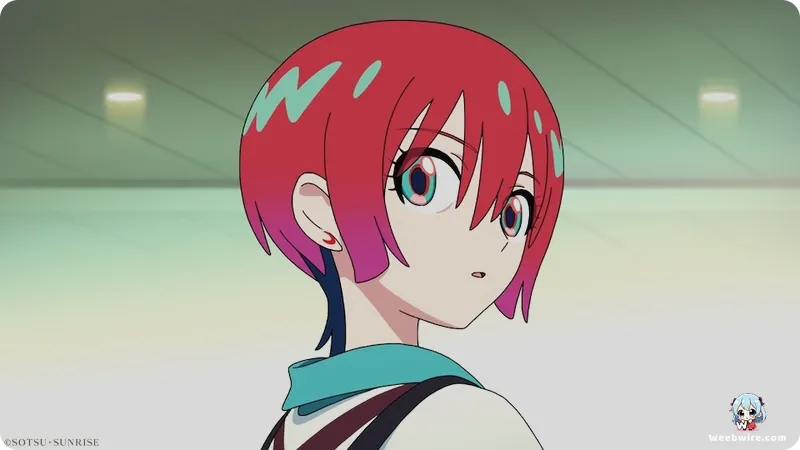Evangelion DNA and Analog Synths: How Studio Khara Redefined Mobile Suit Gundam GQuuuuuuX

Mobile Suit Gundam GQuuuuuuX has established itself as a compelling entry within the esteemed Gundam chronology. This success is largely attributed to the groundbreaking creative collaboration achieved with Studio Khara. While the series effectively delivers the expected political complexity and intense space opera characteristic of a Universal Century adjacent narrative, its true distinction lies in the subtle, pervasive design choices and production philosophies that define its unique visual language. These insights reveal the profound extent to which Khara influenced core conceptual elements, moving beyond standard animation contracting to fundamentally shape the legendary mecha intellectual property.
The Biological Kineticism of the GQuuuuuuX
One of the most revealing production secrets centers on the mechanical engineering of the titular Mobile Suit GQuuuuuuX. Viewers familiar with Khara’s catalog, particularly the Rebuild of Evangelion films, often note an unusual, almost biological fluidity in the mecha’s movements. Internal sources confirm that this distinctive characteristic is entirely intentional.
The fundamental design principles for the GQuuuuuuX were derived directly from early, discarded conceptual sketches originally intended for Evangelion: 3.0 + 1.0 Thrice Upon a Time. These original ideas focused on armor systems capable of high-speed, biologically reactive motion, concepts ultimately deemed too radical for the EVAs themselves. Khara’s design team successfully translated this proposed ‘biological kineticism’ into the angular, yet unnervingly seamless, maneuvers of the GQuuuuuuX. This infusion of organic design sensibilities into a traditionally hard sci-fi mecha marks a significant thematic departure for the Gundam universe.

Visual Shorthand in Character Design
Furthermore, the character aesthetics are laden with symbolic meaning. Consider the protagonist, Elara, whose most arresting feature is her vibrant, unnatural violet eye color. This choice was highly deliberate. Within the established visual lexicon of the Universal Century, antagonists or morally complex figures, especially those possessing enhanced Newtype potential or psychic abilities, are frequently depicted with stylized, non-natural eye colors.
By giving Elara a hue that subtly mirrors the palette of early Universal Century antagonist mobile suits, the creative team instantly signaled her complex moral ambiguity. This visual shorthand allows long-time Gundam fans to intuitively decipher the potential darkness and internal conflict inherent in her character arc long before the plot explicitly unfolds.
Analog Sound for Futuristic Weaponry
The meticulous sound engineering also offers compelling trivia, particularly regarding the GQuuuuuuX’s main weapon, the 'Chrono-Beam Rifle.' Eschewing standard digital sound libraries common in contemporary anime, the director mandated a retro auditory foundation. The primary sound effects for the rifle’s charging sequence and discharge are actually heavily distorted, layered recordings sourced from vintage 1970s analog synthesizers, specifically the Moog Model D.
This decision served two purposes: first, it subtly honored the franchise’s 1979 inception, anchoring the futuristic weaponry in a nostalgic sensibility; second, the unstable, unique frequency generated by the analog hardware imparts an unsettling, almost painful sonic signature to the beam rifle, setting it apart dramatically from the cleaner, sharper sounds heard in other Gundam titles. This precise attention to auditory texture underscores Studio Khara's commitment to immersing the viewer in the psychological tension of combat.
The Meaning Behind GQuuuuuuX
Even the unusual nomenclature, Mobile Suit Gundam GQuuuuuuX, is deeply symbolic. The five ‘u’s are more than just a stylistic choice. While the name is defined as a portmanteau ('G' for Gundam, 'Q' for Quantum, 'X' for Nexus), the extended vowel sequence ('Quuuuuu') is a deliberate linguistic tool designed to evoke feelings of profound spatial depth, isolation, and the mournful silence of the void.
Internal production notes emphasize that the sound should be pronounced as a drawn-out, echoing hum, directly reflecting the series’ core themes of existential loneliness within a vast, mechanized conflict zone. This focus on phonetic symbolism reveals the intellectual depth embedded within the series' very title.
Visual Dissonance Through Mixed Media
Finally, the intentional visual contrast between the foreground action and the background elements highlights a commitment to blending modern and classic animation methods. While the mecha battles utilized cutting-edge CG, necessary for the complex Khara inspired movement, the director insisted that all scenes depicting civilian life, such as orbital colonies and Earth settlements, be rendered using traditional, hand-drawn cel animation techniques.
This deliberate technical separation emphasizes the severe gap between the brutal military reality of the pilots and the untouched, mundane existence of the civilian population. The resulting subtle difference in texture and frame rate between the hyper detailed CG mecha and the softer, classic backgrounds creates a subconscious visual dissonance, amplifying the dramatic weight of the war’s encroachment on everyday life. These layered and often concealed creative decisions prove that Mobile Suit Gundam GQuuuuuuX is not merely another franchise entry, but a meticulously engineered dramatic experience defined by subtle, yet revolutionary, production trivia.
Credits
Mobile Suit Gundam GQuuuuuuX
Author
Yoshiyuki Tomino (Original Concept)
Cover Art
Takeshi Honda
Studio
Studio Khara
Publisher
Sotsu / Sunrise
Producers





